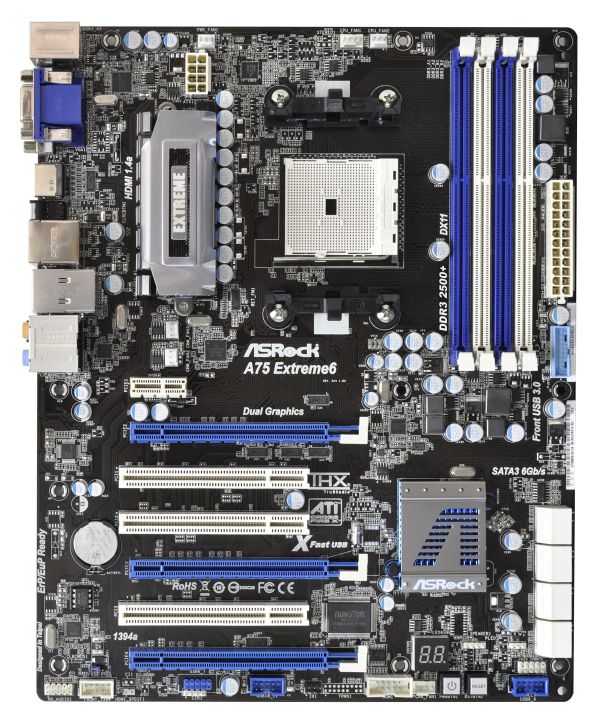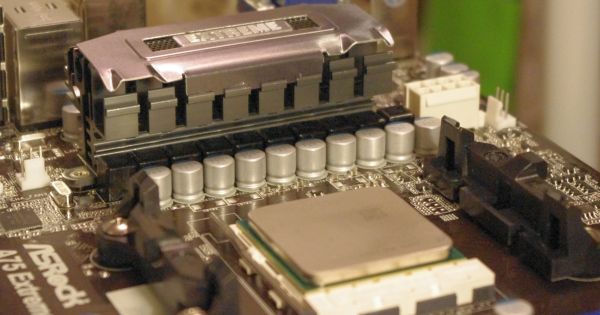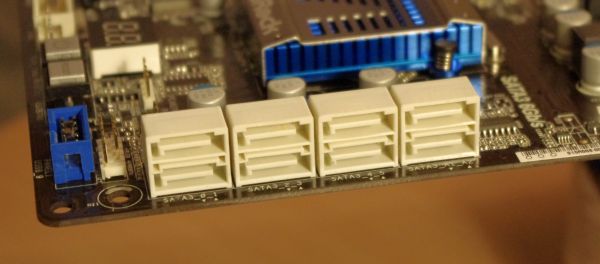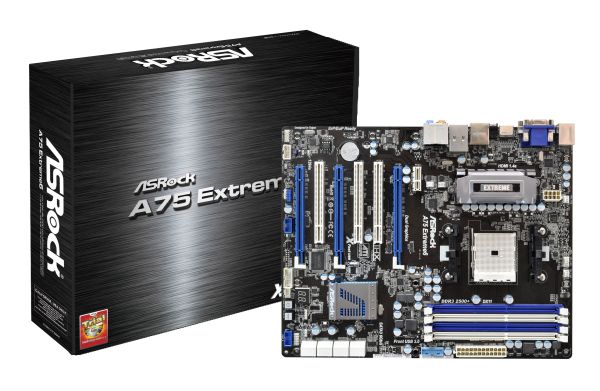ASRock A75 Extreme6 Review and Desktop Llano Overclocking
by Ian Cutress on June 30, 2011 12:05 AM ESTOur initial tests with the ASRock A75 Extreme6 were based on a pre-release model, and shown in our preview. At that point, the board design was not finalized and the BIOS was still quite raw, but the performance was essentially complete. However, now in my grasp is the full release version of the Extreme6. Alongside this standard motherboard review, and testing to see whether it's worth the $150 asking price, we're also going to take a good look at the overclocking features of the Desktop Llano chipset.
I've essentially run our motherboard test suite on two versions of this board now, and having recently played with Cougar Point and AMD Fusion (review to come), it slots nicely in the middle in most aspects - especially CPU power. We're not seeing anything special here with Desktop Llano - as Anand pointed out, in the region of Phenom II X4 performance. For the integrated GPU, it's a different matter, with up to 2x the performance of the highest version of Intel's integrated graphic solutions of the Sandy Bridge second generation Core series. Both of these will come in the form of results I will look at later.
Overview
The ASRock A75 Extreme6 is aimed at the high end Desktop Llano workspace, and, from what ASRock are telling me, will ship in at $150. Unfortunately, I haven't other A75 boards to compare it to yet, but I get the same steady feeling I've got from ASRock boards of late - it's just something that works. There's one minor glitch for now that I've found, to do with memory compatibility, but what we're dealing with here on the board is a good number of features, and the only real downside is the Llano chip itself.
If we look at the prices of the 890 chipset, most motherboards are in the $100-$145 range, so in terms of CPU performance, we're paying a little extra. With the integrated APU at hand, however, you could see where the extra comes from - a different power integration arrangement, and the need for various video output connectors. Personally, I see Desktop Llano more of a niche area, so it will be interesting to see how aggressive the motherboard manufacturers are with pricing.
Visual Inspection
Desktop Llano features the same retention bracket spacing as AM2 and AM3, which, in all honesty, is quite big compared to Intel's chipsets. As a result, we see a bunched up power delivery to the west of the socket itself, covered in a large heatsink of ASRock's design (this is a main difference to the preview board I tested earlier). The chokes on this design are still of the old design - if you can recall, during my tour with ASRock at Computex, I noticed they were using a different choke design on their high end boards to improve power delivery, heat generation and efficiency (similar to MSI's SFC). It seems that the new design still hasn't filtered down into their non-gaming products; despite the fact that I was told that the two choke designs cost the same.
The socket area itself has five fan headers, of which I highly approve and would like to see on every other motherboard on the market - I'm using a Corsair H50, which in dual fan mode requires three (two for fans, one for the pump), so having another couple at hand for case fans is always a plus. Two of the fan headers are labelled for the CPU (one four pin, one three pin), the two under the power delivery are chassis headers (both three pin), and the one above the power delivery is a PWR fan (again, three pin). Elsewhere on the board is one more fan header, labelled as chassis (another three pin).
Beyond the 24-pin ATX connector is a USB 3.0 header, but unfortunately no USB 3.0 bracket comes with this ASRock board like their Sandy Bridge Extreme series. The eight (yes, eight) SATA 6 Gb/s ports come in a couple of flavors - six from the Fusion Controller Hub (FCH), and two more from an ASMedia controller. We also see the Power/Reset/Debug LED combo, which I approve of.
The FCH heatsink is ASRock's low profile, silent design, which actually gets quite warm when anything is overclocked. PCIe design is x1, x16, PCI, PCI, x16, PCI, x4 - with the x16 slots running at x8/x8 mode when two discrete GPUs are being used.
The I/O panel is actually fairly bare, as ASRock haven't decided to stack anything on top of the HDMI. With some extra effort, I'm sure a pair of USBs could be stacked on top of it. Actually, in my initial preview piece, I stated how the USB ports on the far left (physically at the top of the board) were quite tough to get anything in beyond a USB mouse or keyboard if the DVI video out was used. ASRock's response was to 'use a USB port extender - we had to cater for those using DVI + HDMI at the same time', which in my eyes is a stone's throw away from 'oops, we didn't spot that'. Other connectivity comes in the form of a PS/2 port, two native USB 3.0 ports, two USB 3.0 ports from an ASMedia ASM1042 controller, a VGA port, two USB 2.0 ports, an eSATA 3 Gbps port, Realtek controller enabled gigabit Ethernet, a Firewire port, an optical SPDIF out, and the standard audio outputs.















44 Comments
View All Comments
Exodite - Thursday, June 30, 2011 - link
I'd agree that no common task /requires/ an i3 2100, or a Llano equivalent, but between the two of them the former is the better option for such.Most significantly Llano /doesn't/ have a much better graphics solution. Sure, it's better but still not good enough to do native resolution gaming and low/mid settings - which is the bare minimum for gaming at this day and age.
For anything else, speaking about the GPU-side of things, anything will suffice. Certainly both Llano and Intel's HD2000/HD3000 solutions.
Perhaps I were overly enthusiastic about Llano's GPU prowess, I didn't expect it to be quite as memory-starved as it was, but I always envisoned it being a lot closer to what a discrete solution with the same clocks and core count would offer.
As it is I'd recommend an Intel solution to anyone at this point, with or without a discrete card as required.
You may chose to scream bloody murder about it if you want to, it's no skin of my back, but the numbers do speak for themselves.
mino - Thursday, June 30, 2011 - link
"I'd agree that no common task /requires/ an i3 2100, or a Llano equivalent, but between the two of them the former is the better option for such."Yeah, between the two i3 is a better option for uncommon single-threaded tasks.
Now, what have those to do with the low-end desktop market?
L. - Thursday, June 30, 2011 - link
Bloody Murder !No shit ... "doesn' t have a much better graphics solution" ...
Seriously read a few other reviews and you'll understand there is a world of difference between 11 fps and 30, dx11 and no dx11, etc.
There are MANY games which lie on the fringe of "playable" with a Llano which are clearly unplayable on an i3.
The fact that this review is not showing is that with all those, the difference is between play and no play, and everytime the Llano is far ahead.
I linked a review in the comments of the OC article here on AT and it shows things ... like 11 fps crysis gamer settings @ 1920x1080.
While 11fps is not playable, 11fps in crysis w/ those settings and that resolution implies almost everything is playable with some stuff tuned down.
THIS IS NOT THE CASE with an i3.
The difference might be hidden w/ these benchmarks but it's there and so big it cannot justify the pricing of the i3 2105.
Llano is good enough to do native resolution gaming @ low / mid settings, even if you consider native to be full HD, there are many many many games that are playable on it this way.
http://www.xbitlabs.com/articles/cpu/display/amd-a...
Yet another one ... high quality, full HD, far cry 2 , playable on Llano, 11 fps on HD3000.
Finally - Thursday, June 30, 2011 - link
A German magazine has proven that a Llano will run fine with DDR3-1600 (and upwards). It's called computerbase, have a look: http://tinyurl.com/6zsv6kkFinally - Thursday, June 30, 2011 - link
DDR3-1600 RAM isn't that much more expensive than the run-of-the-mill type... both are ridiculously cheap right now.With only 65€ for 8GB of (good gamer) RAM, I'd say that this has already become the new standard minimum amount.
havoti97 - Sunday, July 3, 2011 - link
You are not entitled to anything. You get what's given to you. If you don't like it, go look elsewhere or do yar own benchmark.L. - Thursday, June 30, 2011 - link
This is almost correct.a) s1155 prices have dropped, you can expect A75 to do the same
b) Llano is AMD and WILL be cheaper
c) The core i3 2100 is way overkill for flash, full hd and basic stuff
d) For that you have a 18W e-350 that's so much more money and power efficient
e) Office desktops do NOT need the power of an i3-2100
Besides, you seem to think the GPU is useless outside of games, might be partly true today but it's not meant to last.
ganteng3005 - Thursday, June 30, 2011 - link
IMHO it's not that GPU is useless outside of games (even Windows Aero requires a "real" GPU to run), but what I'm saying is that Intel HD Graphics is sufficient for daily usage except gaming and graphical computing. I might be incorrect, though, but for me, personally, an i3 2100 is sufficient (even overkill, I agree) for office tasks.E-350 and Pentium G620 (SB) might be better in price/performance, but what I've noticed from the E-350 (and of course, Intel Atom) is the lack of real-time responsiveness on laptops. It might be just me, though.
kevith - Thursday, June 30, 2011 - link
Does that mean to say, that I´ll not be able to run Windows Aero with any buil-in GPU? AMD or Intel...StormyParis - Thursday, June 30, 2011 - link
"Besides, you seem to think the GPU is useless outside of games, might be partly true today but it's not meant to last.".We'll see when we get there. The industry has a terrible, terrible record of adapting software to new hardware, especially to new CPU instruction sets / capabilities. Look at all the x86 extensions that are still barely used (anything after SSE2 ?).
My take it... that exact same quote will still apply 3 yrs from now, and by then, we'll be due for an upgrade ^^